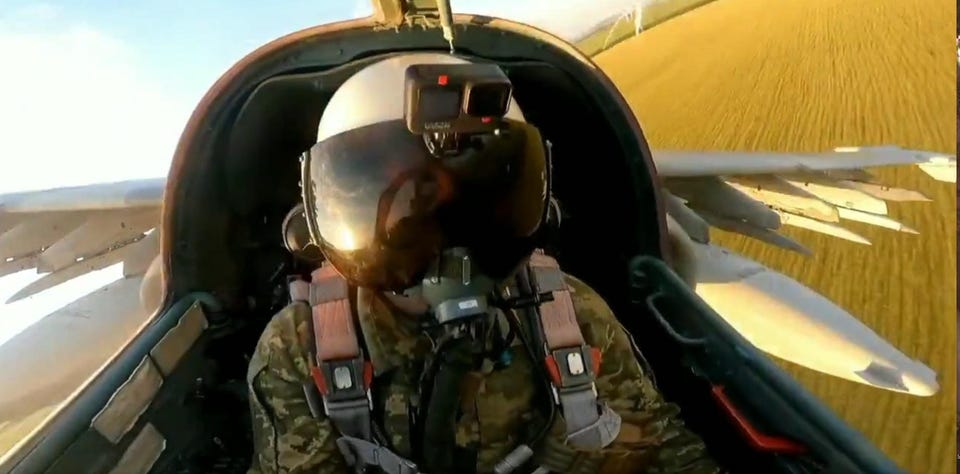Aerospace & Defense Editors’ Pick Russian Jets Are Flying So Low To Dodge Ukrainian Air-Defenses That They’re Running Into The Ground David Axe Forbes Staff I write about ships, planes, tanks, drones, missiles and satellites. New! Follow this author to improve your content experience. Got it! Jun 24, 2022, 08:00am EDT | Share to Facebook Share to Twitter Share to Linkedin A low-flying Ukrainian air force Su-25.
Ukrainian air force capture Desperate to avoid surface-to-air missiles in the lethal air space over Ukraine, Russian and Ukrainian pilots have revived a classic tactic—flying really, really low. But the same low flying that helps pilots to dodge enemy air-defenses also exposes them to a separate risk: collisions with the terrain. In just the past week or so, the Russian air force has lost two Su-25 attack planes, and at least one pilot, in crashes during low-level flights to or from the war zone.
The sky over Ukraine—in particular, eastern Ukraine where the fighting is the most intensive—is some of the most dangerous in the world for crews on both sides of the conflict. In four months of warfare, the Ukrainian and Russian air forces have written off around a fifth of their deployed fixed-wing aircraft, as well as many helicopters. Ukraine has lost 39 manned aircraft that independent analysts can confirm; Russia has lost 81.
It’s unclear how many aviators have died, but it’s likely most of the shoot-downs and crashes involved at least one fatality. The sheer density of air-defenses helps to explain the steep losses. Both Ukraine and Russia deploy overlapping air-defense systems including short-range, shoulder-fired infrared surface-to-air missiles, or SAMs; medium-range SAMs with infrared, optical or radar guidance; as well as long-range radar SAMs.
Flying extremely low mitigates the missile risk. Radars can lose low-flying aircraft in the clutter of radar returns from buildings, trees and hills. Soldiers with shoulder-fired missiles can’t shoot what they can’t see—and an aircraft flying close to the ground can appear and disappear over the horizon in mere seconds.
MORE FOR YOU American Airlines Pilots Say Operations Managers Must Go After Summer Breakdowns The U. S. Air Force Is Gradually Rebuilding Its B-52 Bombers From The Rivets Out An American Bomber Visited Malaysia.
A Bizarre Mix Of Local Jets Rose To Meet It. Low-flying allowed Ukrainian crews to continue supplying the garrison at the Azovstol steel plant in occupied Mariupol, in southern Ukraine, for weeks after Russian forces fully surrounded the port city back in early March. A pair of Mi-8 transport helicopters would fly through Russian air-defenses at 130 miles per hour as close as 10 feet from the ground.
“We had to fly over the power lines sometimes, and that was a risky maneuver given the speed,” one pilot told ABC News. The Russians eventually caught on to the Ukrainians’ flight profiles and began positioning SAMs to interdict the Mariupol resupply missions, shooting down several helicopters and compelling Kyiv to halt the flights. But without very low flying, no resupply would have been possible.
Super-low flying now is standard across the Ukraine war zone. But while it might protect crews from missiles, it also increases the risk from accidents. It surely doesn’t help that the Russian air force in particular appears to be having problems training and retaining skilled pilots.
It’s not for no reason that more and more Su-25s in particular are being flown by aging ex-servicemembers who now work for the Wagner Group, Russia’s shadowy mercenary company. At least two Wagner pilots have been shot down over Ukraine, an indication that Moscow is throwing money at its manpower problems. Flying low and fast, safely, takes a lot of practice.
And that takes time. As losses mount, time-consuming training is a luxury neither the Russians nor Ukrainians can afford. The back-to-back crashes of two Russian Su-25s might imply that crews, in their urgency, are trading one danger for another.
Better to fly low and risk clipping a tree or hill—which might kill you—than to fly higher and risk catching a missile, which almost certainly will kill you. Follow me on Twitter . Check out my website or some of my other work here .
Send me a secure tip . David Axe Editorial Standards Print Reprints & Permissions.
From: forbes
URL: https://www.forbes.com/sites/davidaxe/2022/06/24/russian-jets-are-flying-so-low-to-dodge-ukrainian-air-defenses-that-theyre-running-into-the-ground/



